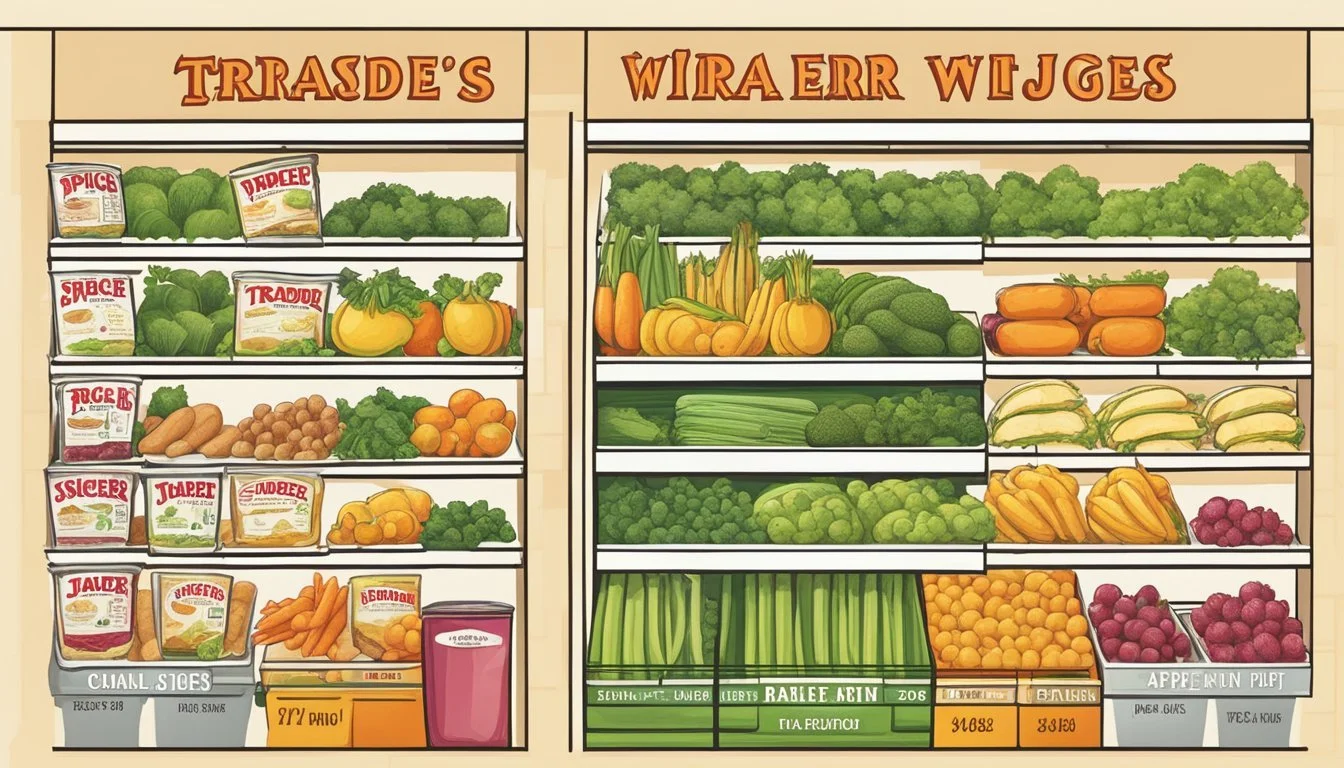Is Trader Joe's Cheaper Than Piggly Wiggly?
A Cost Comparison Guide
Part of Our Grocery Store Guide with Details on Trader Joe's Prices and Piggly Wiggly Prices
When consumers consider where to shop for their groceries, the cost is often a major deciding factor. Trader Joe's, a national chain known for its unique food items and competitive pricing, is frequently discussed in conversations about affordable grocery shopping. As a contrast, Piggly Wiggly, with its deep roots in the American South as a self-service grocery store, has a different market presence and varies in its regional pricing strategies.
Comparing the two, Trader Joe's adopts a pricing strategy that tends to offer lower prices on many items, particularly their store brands, when compared to traditional grocery stores. This affordability extends to a variety of goods ranging from spices and nuts to freezer items, often making it a go-to option for budget-conscious shoppers. On the other hand, Piggly Wiggly's prices for groceries can differ considerably based on its independent ownership and location, presenting a less consistent pricing landscape across its stores.
The distinction in pricing between Trader Joe's and Piggly Wiggly also takes into account the types of items purchased. With Trader Joe's focus on house-brand products, which are often priced lower than comparable national brands, it can lead to savings for customers who don't mind skipping the bigger-name labels. Piggly Wiggly, while offering a selection of store brands, also provides a wide range of national brands, which might affect the store's overall pricing and deals in turn.
Understanding Grocery Store Pricing
When entering the complex landscape of grocery store pricing, consumers often seek to understand why prices vary between stores. An informed shopper understands that multiple factors influence the prices they see on the shelves, and applying a consistent methodology allows for effective price comparisons.
Factors Influencing Prices
Geographical Location: A store's region can greatly impact its pricing, as it affects transportation costs, local taxes, and operational expenses. Urban stores might have higher prices due to increased rent and logistics costs.
Store Brand versus Name Brand: Retailers like Trader Joe's predominantly offer store brand items which are commonly priced lower than name brands found in stores such as Piggly Wiggly. This can lead to significant price disparities between similar items.
Volume of Sales: Stores with higher foot traffic typically move products faster and can leverage economies of scale. This can result in lower prices due to bulk purchasing and reduced holding costs.
Supply Chain Efficiency: Retailers with a streamlined supply chain often have lower operational costs, translating to savings for the customer. A simplified supply chain can also impact freshness and quality, which are key price points for perishables.
Discounts and Promotions: Periodic deals, loyalty programs, and discounts affect price perception. Shoppers must determine if these deals offer true savings or are marketing tactics to increase overall spending.
Price Comparison Methodology
Unit Price Analysis: It is crucial to compare price per ounce or per unit when gauging the best deal. This standardized measurement removes quantity discrepancies and provides a clearer baseline for comparison.
Sample Basket Comparison: Researchers often compile a basket of common goods — like the 50-item staples list — to compare overall costs between stores. This method highlights which retailer offers the lowest cumulative price for everyday items.
Price Tracking Over Time: Consistent monitoring of prices for staple items provides a historical view of price trends. This illustrates not just the snapshot of present prices but also the long-term savings potential a retailer offers.
In short, a detailed understanding of the factors affecting grocery store pricing and a structured approach to comparison empowers the consumer to find the most economical options, potentially leading to substantial savings.
Trader Joe's Overview
Trader Joe's stands out in the retail market for its distinctive business approach, curated product selection, and a focus on its store brand products, which together deliver high-quality at competitive prices.
Business Model
Trader Joe's operates as a specialty retail grocery store and is renowned for its unique business model. By purchasing directly from suppliers and eschewing traditional middlemen, the company is able to offer high-quality goods while keeping operational costs low. This direct sourcing approach allows them to pass the savings onto consumers. Additionally, it invests in energy-efficient lighting and other cost-saving measures to maintain low overhead expenses.
Product Selection
They are known for offering a wide array of products, many of which are organic, non-GMO, and free from artificial preservatives and colors. The product selection strategy is centered around stocking a smaller assortment compared to typical supermarkets, but with a focus on unique and gourmet options that cater to the demands of their customer base. Trader Joe's continually rotates its product offerings to keep the selection fresh and engaging.
Store Brand Focus
A significant portion of Trader Joe's shelf space is dedicated to its private label products, which are designed to match or exceed the quality of national brands. This store brand focus is part of what garners a loyal customer base. The store's dedication to its own branding allows it to maintain quality control and offer items with an appealing price-to-quality ratio. By avoiding external branding, Trader Joe's further reduces its operational costs, leading to lower prices for consumers.
Piggly Wiggly Overview
Piggly Wiggly, recognized for its customer-centric approach and self-service format, is a notable player in the competitive retail grocery market. With a rich history that dates back to the early 20th century, the company has played a substantial role in shaping the grocery shopping experience.
Company History
Piggly Wiggly was founded in 1916 by Clarence Saunders in Memphis, Tennessee. It has the distinction of being the first self-service grocery store in the United States, revolutionizing the way consumers shop for groceries. The chain quickly expanded, and by the mid-1920s, Piggly Wiggly had more than 1,200 stores across the United States.
Marketing and Advertising
The company employs distinctive marketing and advertising strategies that emphasize its local community presence and competitive grocery prices. Piggly Wiggly is known for its weekly promotions and discounts, tailoring its advertising to highlight cost savings on popular items. While not as large as some competitors, Piggly Wiggly maintains its brand recognition through a combination of traditional and digital marketing efforts, connecting with customers in their local areas.
Cost Analysis and Budget Impact
In evaluating whether Trader Joe's is cheaper than Piggly Wiggly, it’s essential for consumers to consider their own spending patterns and the savings opportunities unique to each store. This analysis will demonstrate the potential budget impact when shopping at these grocery chains.
Average Consumer Spending
At Trader Joe's, customers may find everyday items such as a pound of spaghetti for as low as $0.99, while organic low-sodium chicken broth is priced at $1.99. These prices compare favorably against Piggly Wiggly, where similar products may cost marginally more. Since Trader Joe's offers a variety of store-brand products at competitive prices, this can influence the average consumer's weekly spending. Prices at Piggly Wiggly can be competitive, especially for regional products or during special sales events.
Saving Opportunities at Each Store
Trader Joe's
Offers a selection of their own brand products, often at lower prices compared to national brands.
Infrequent promotions, relying instead on everyday low prices.
No loyalty programs, but certain discounts are available through occasional markdowns.
Piggly Wiggly
Regularly provides coupons and weekly ads with discounts on various products.
Loyalty program that allows consumers to save money by earning points on purchases.
Special discounts can be found on perishable items nearing their sell-by date, allowing for significant savings.
By focusing on the saving mechanisms unique to each store, consumers can strategically plan their purchases to align with sales and discounts, thereby optimizing their grocery budget.
Product-by-Product Price Comparison
When examining the pricing between Trader Joe's and Piggly Wiggly, it is valuable to assess how each store prices essential items across various categories. Direct comparisons can offer insight into where consumers might find the best value for their grocery shopping needs.
Staple Grocery Items
Comparing staple items, Trader Joe's typically offers bread and eggs at a competitive price point. For example, a loaf of whole wheat bread and a dozen large eggs can be more affordable at Trader Joe's, often saving shoppers a few cents to over a dollar on these essentials when compared to Piggly Wiggly's pricing.
Fresh Produce
In the produce section, bananas stand out as a commonly purchased item. Trader Joe's usually has a lower price per pound for bananas, providing an economical choice for shoppers. Prices for other fresh produce such as apples and lettuce also tend to lean in Trader Joe's favor, making it an attractive option for buying fruits and vegetables.
Meats and Dairy
Meat and dairy are pivotal categories when comparing grocery costs. Trader Joe's is known for its organic milk and chicken breasts, often priced below Piggly Wiggly's non-organic offerings. For ground beef and cheddar cheese, Trader Joe's also frequently undercuts Piggly Wiggly, though the price difference might be less pronounced than with other items.
Snacks and Packaged Goods
Snack lovers will find that Trader Joe's offers snacks and packaged goods at prices that are usually on par with or better than those at Piggly Wiggly. Packaged almond milk and name-brand cereal equivalents, for example, are areas where Trader Joe's may offer the better deal.
Quality Comparisons
When comparing Trader Joe's to Piggly Wiggly, notable differences emerge, particularly in store brands, produce freshness, and meat and seafood quality. These factors significantly influence purchasing decisions, especially for consumers focused on quality.
Store Brands versus National Brands
Trader Joe's store brand is known for offering quality that rivals national brands, often at a reduced cost. Shoppers frequently find that Trader Joe's groceries, including spices and baked goods, maintain a high standard. On the contrary, Piggly Wiggly also offers competitive store-brand items, with many consumers finding their products comparable in quality to household name brands.
Freshness of Produce
Freshness in the produce aisle is a major concern for consumers interested in a healthy diet. Trader Joe's is recognized for its selection of fresh produce, with items such as bananas frequently touted for both quality and affordability. Piggly Wiggly competes with a focus on locally-sourced options which may cater to those looking for regional freshness.
Meat and Seafood Standards
The quality of meat and seafood is a telling aspect of a grocery store's commitment to excellence. Trader Joe's offerings like its salmon are often praised for both quality and price. Meanwhile, Piggly Wiggly provides a variety of meats, including custom cuts and specialty items. Customers shopping for meat and seafood will find that both stores place a high emphasis on quality standards within their respective market ranges.
Consumer Shopping Experience
When comparing Trader Joe's and Piggly Wiggly, shoppers often focus on the differences in customer service and store layout, which can greatly affect their overall grocery shopping experience.
Customer Service
Trader Joe's is known for its friendly employees who are eager to assist shoppers in finding items. Interaction with staff is generally pleasant, and employees tend to exhibit knowledge of the store's products, which can aid customers in making purchasing decisions. Piggly Wiggly also prioritizes customer service, with employees available to help with questions about products and store navigation.
Store Layout and Design
The layout and design of Trader Joe's are distinctive, typically featuring narrower aisles and shelves stocked with a mix of basic staples and exotic, trendier food items that are often Trader Joe's brand. This design encourages shoppers to explore and discover new products. Piggly Wiggly stores offer a more traditional grocery store design, with wider aisles and a familiar organization of goods, allowing customers to quickly find known brands and essentials.
Loyalty Programs and Discounts
When comparing loyalty programs and discounts between Trader Joe's and Piggly Wiggly, one notes significant differences in how these stores approach savings for their customers.
Membership Savings
Trader Joe's does not offer a loyalty program, thereby maintaining its strategy to keep low prices across the board. Trader Joe's lacks membership savings, focusing instead on presenting all customers with what it perceives as the best prices without additional loyalty incentives. In contrast, Piggly Wiggly provides a 5% discount for certain customers, such as seniors, on most items, emphasizing the conventional approach of rewarding frequent shoppers.
Weekly Specials and Deals
Piggly Wiggly features weekly specials that present customers with the opportunity to purchase select items at reduced prices. These deals are often communicated through flyers and in-store promotions. Trader Joe’s, however, does not organize traditional sales or weekly specials. Instead, they emphasize consistent pricing and occasional new product introductions at a value. They stress their everyday low pricing strategy as opposed to periodic deals.
Beyond the Price Tag
When comparing Trader Joe's and Piggly Wiggly, the consideration extends beyond just the cost of groceries. Consumers are increasingly factoring in sustainability and community impact when choosing where to shop.
Environmental and Ethical Considerations
Trader Joe's has committed to sustainability by reducing package sizes, eliminating certain harmful chemicals, and offering a growing selection of organic products. They prioritize products with fair trade certifications and have taken steps to ensure that their private-label products don't contain genetically modified organisms (GMOs). Additionally, they are transparent about their efforts to improve their carbon footprint, such as investments in renewable energy.
Piggly Wiggly, on the other hand, emphasizes supporting local farmers and suppliers, which can reduce the environmental impact of transportation. They offer a selection of locally-sourced produce, which not only supports the local economy but often results in fresher options for consumers.
Community Involvement
Trader Joe's engages with communities by contributing to local non-profits and participating in food recovery programs. They also encourage their employees to volunteer in their communities, which reflects their commitment to local values and goodwill.
Piggly Wiggly has a long-standing tradition of community involvement, often supporting local events and charities. They foster a sense of community by providing a personal shopping experience and customer service, and by tailoring store offerings to the preferences of the local community.
Alternative Grocery Options
When comparing grocery prices, it's essential to look beyond Trader Joe’s and Piggly Wiggly. Consumers have a variety of choices, ranging from chains like Aldi and Walmart to online options such as Amazon.
Comparing with Other Retailers
Aldi often emerges as a cost-effective alternative, often undercutting competitors on basic staples. Pricing strategies at Aldi have maintained their lead as a budget-friendly choice over the years. Walmart, known for its wide reach and competitive pricing, is another major player in the grocery sector. However, their prices have been noted to fluctuate, sometimes falling behind that of Aldi’s consistency.
Consumers also turn to Costco, where bulk purchases can translate into long-term savings. Costco's membership model provides discounts that can be substantial when the savings are spread over the numerous items sold in larger quantities.
Online Shopping Alternatives
For customers who prefer shopping from home, Amazon offers a vast selection of grocery items. Its prices can be competitive, and the convenience of home delivery adds to the appeal for many consumers. They can choose from a wide range of products across various categories, often with the advantage of user reviews to guide their choices.
As the landscape of grocery stores evolves, consumers benefit from the competition among retailers. By doing so, they can make informed decisions based on their specific needs, preferences, and budgets.
Grocery stores in general, whether independent or chain, can vary greatly in pricing. Shopping strategies such as comparing unit prices and taking note of sales and discounts can make a noticeable difference in expenses.
Both in-store and online options provide the consumer with the flexibility to shop according to their preferences, each with its own set of advantages.
Conclusion
This section distills the essence of the comparison between Trader Joe's and Piggly Wiggly, focusing on the economic aspects of grocery shopping.
Final Recommendations
When considering grocery prices, Trader Joe's often exhibits a pricing advantage, typically 10% to 20% lower than other grocery retailers. However, the comparison to Piggly Wiggly specifically may yield variable results depending on location, product selections, and local price strategies. Shoppers are encouraged to consider value alongside savings, as Trader Joe's offers a unique selection of products that may justify any potential cost differences.
Customers should also weigh the convenience, product quality, and overall shopping experience when comparing the two stores. It's advisable for consumers to perform a periodic review of their receipts or conduct a personal item-by-item comparison to identify which retailer provides the best overall value for their specific needs.









